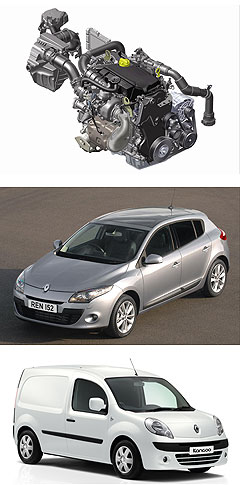News - RenaultRenault rules 1.6-litre diesel roost with dCi 130Scenic view: Renault’s Megane-based Scenic people-mover is the first model to benefit from the company’s powerful new 1.6-litre diesel engine. All-new 97kW ‘Energy’ diesel engine set to spread across Renault Megane range19 May 2011 BILLED as the world’s most powerful 1.6-litre turbo-diesel engine, Renault’s new-generation ‘Energy dCi 130’ (130hp/97kW) has made its production debut in the Megane Scenic people-mover in Europe and will soon spread throughout the Megane range. Renault Australia was this week unable to confirm details of the engine’s introduction in Megane and other models sold here, although the French manufacturer has stated that the all-new diesel – which was first seen at the Paris motor show last October – is poised to become a core powerplant for its C-segment (small-car) models. The Energy dCi 130 is also highly likely to feature in European versions of the D-segment Latitude and certain van models like the Kangoo. Renault Australia currently does not offer a diesel option in its top-selling Megane hatch and cabriolet or its twin-under-the-skin Fluence sedan, with the 102kW/195Nm 2.0-litre petrol engine the only powerplant available here. Renault Australia spokesperson Emily Ambrosy told GoAuto this week that the engine was being trialled in the Scenic and that dates for its release in other models overseas were not known. As such, she said “it’s not something that we have on the agenda in the near-future at this stage”.  From top: Renault's 1.6-litre Energy dCi engine, Renault Megane, Renault Kangoo. From top: Renault's 1.6-litre Energy dCi engine, Renault Megane, Renault Kangoo.The diesel is the latest step in the Renault’s downsizing trend, following the European release of 1.2 and 1.4-litre TCe petrol engines and an upcoming three-cylinder modular engine family. Compliant with the Euro 5 emissions standard, the almost-square (80x79.5mm bore/stroke) 1598cc engine produces the same 97kW of power (at 4000rpm) as the current 1.9-litre turbo-diesel, while the torque figure has grown by 20Nm to 320Nm, available from 1750rpm. With the addition of fuel-saving measures such as engine idle-stop, the Energy dCi 130 fitted to the Scenic enables fuel consumption of 4.4L/100km on the EU combined cycle. CO2 emissions come in at 115g/km, down from 149g/km with the outgoing 1.9 diesel. The engine project was also developed within the framework of the Renault-Nissan global alliance, meaning the engine will be available in as-yet-unknown Nissan models. Despite continuing to struggle in the sales race, Renault has released six new models in the past seven months in Australia, including the Latitude large sedan in April, the Fluence small sedan, an upgraded Trafic medium van and light-sized Clio RS200 Australian Grand Prix limited-edition hot hatch in March. It also introduced the all-new Kangoo compact van in December and the redesigned Megane hatchback, coupe-convertible and (RenaultSport 250) coupe models in October last year. Renault’s next-generation Clio light car – a model which is currently only available in RenaultSport RS200 guise Down Under – could also come to Australia after it makes its global debut in 2012. The French manufacturer’s burgeoning range of EV models, including the Kangoo and Fluence ZE models, and the forthcoming Zoe light car and Twizy car/scooter, are unlikely to lob onto the local market any time soon. It also became the first European brand to release a five-year warranty in Australia in April, while earlier this month it launched its Financial Services operation with a super-low introductory rate of 1.9 per cent on most passenger cars.  Read more |
Click to shareRenault articlesResearch Renault Motor industry news |
















Facebook Twitter Instagram